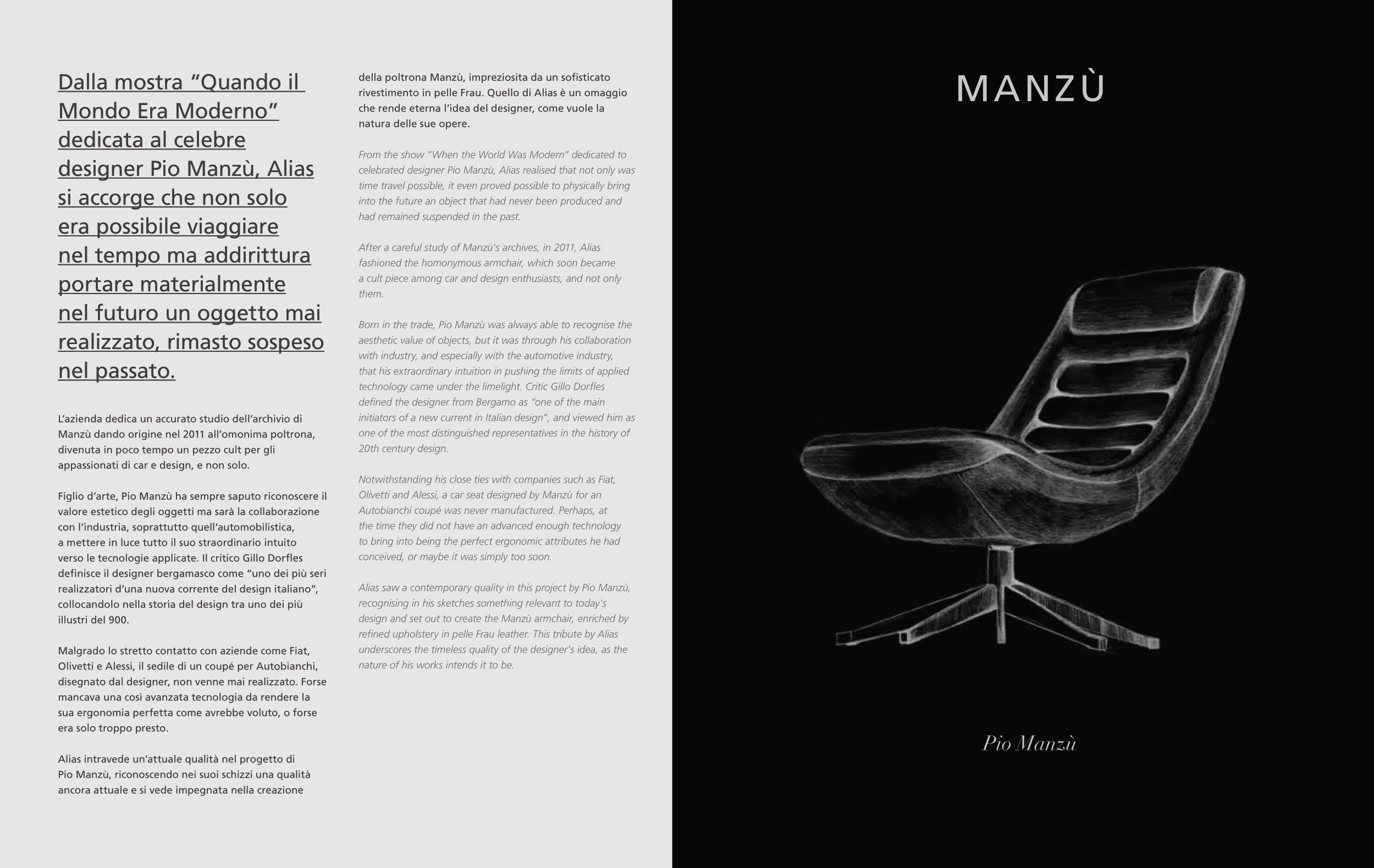Dalla mostra “Quando il
Mondo Era Moderno”
dedicata al celebre
designer Pio Manzù, Alias
si accorge che non solo
era possibile viaggiare
nel tempo ma addirittura
portare materialmente
nel futuro un oggetto mai
realizzato, rimasto sospeso
nel passato.
L’azienda dedica un accurato studio dell’archivio di
Manzù dando origine nel 2011 all’omonima poltrona,
divenuta in poco tempo un pezzo cult per gli
appassionati di car e design, e non solo.
Figlio d’arte, Pio Manzù ha sempre saputo riconoscere il
valore estetico degli oggetti ma sarà la collaborazione
con l’industria, soprattutto quell’automobilistica,
a mettere in luce tutto il suo straordinario intuito
verso le tecnologie applicate. Il critico Gillo Dorfles
definisce il designer bergamasco come “uno dei più seri
realizzatori d’una nuova corrente del design italiano”,
collocandolo nella storia del design tra uno dei più
illustri del 900.
Malgrado lo stretto contatto con aziende come Fiat,
Olivetti e Alessi, il sedile di un coupé per Autobianchi,
disegnato dal designer, non venne mai realizzato. Forse
mancava una così avanzata tecnologia da rendere la
sua ergonomia perfetta come avrebbe voluto, o forse
era solo troppo presto.
Alias intravede un’attuale qualità nel progetto di
Pio Manzù, riconoscendo nei suoi schizzi una qualità
ancora attuale e si vede impegnata nella creazione
della poltrona Manzù, impreziosita da un sofisticato
rivestimento in pelle Frau. Quello di Alias è un omaggio
che rende eterna l’idea del designer, come vuole la
natura delle sue opere.
From the show “When the World Was Modern” dedicated to
celebrated designer Pio Manzù, Alias realised that not only was
time travel possible, it even proved possible to physically bring
into the future an object that had never been produced and
had remained suspended in the past.
After a careful study of Manzù's archives, in 2011, Alias
fashioned the homonymous armchair, which soon became
a cult piece among car and design enthusiasts, and not only
them.
Born in the trade, Pio Manzù was always able to recognise the
aesthetic value of objects, but it was through his collaboration
with industry, and especially with the automotive industry,
that his extraordinary intuition in pushing the limits of applied
technology came under the limelight. Critic Gillo Dorfles
defined the designer from Bergamo as “one of the main
initiators of a new current in Italian design”, and viewed him as
one of the most distinguished representatives in the history of
20th century design.
Notwithstanding his close ties with companies such as Fiat,
Olivetti and Alessi, a car seat designed by Manzù for an
Autobianchi coupé was never manufactured. Perhaps, at
the time they did not have an advanced enough technology
to bring into being the perfect ergonomic attributes he had
conceived, or maybe it was simply too soon.
Alias saw a contemporary quality in this project by Pio Manzù,
recognising in his sketches something relevant to today's
design and set out to create the Manzù armchair, enriched by
refined upholstery in pelle Frau leather. This tribute by Alias
underscores the timeless quality of the designer's idea, as the
nature of his works intends it to be.
MANZÙ
Pio Manzù







